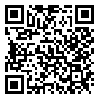Volume 6, Issue 16 (4-2011)
2011, 6(16): 145-168 |
Back to browse issues page
Download citation:
BibTeX | RIS | EndNote | Medlars | ProCite | Reference Manager | RefWorks
Send citation to:



BibTeX | RIS | EndNote | Medlars | ProCite | Reference Manager | RefWorks
Send citation to:
Arab Bafrani A. A rhetorical critical study of the story of " Zaal and Roudabeh" in Ferdowsi’s Shahnameh and the Story of "Jamshid and the king of Zabol’s daughter" in Asadi’s Garshasbnameh. Journal title 2011; 6 (16) :145-168
URL: http://jls.khu.ac.ir/article-1-1797-en.html
URL: http://jls.khu.ac.ir/article-1-1797-en.html
Naeen Payam Noor University , bafrani57@gmail.com
Abstract: (11417 Views)
What has been told about Shahnameh and Shahnameh – reciting in different books notifies the superiority of Ferdowsi’s skill in his "the high palace". One of the reasons which provide evidence as to Ferdowsi’s fascinating discourse is considering the rhetorical issues, organizing the draft and unifying the tone of Shahnameh. Considering rhetorical issues and especially the skill of story – telling is a point which most of the followers have not noticed yet. A relevant example is Garshasbnameh by Asadi Tousi which although some theorists have considered it as the successor of Shahnameh, it provides nothing but a mere imitation. This paper examines the rhetorical comparison between the story of "Zaal and Roudabeh" in Ferdowsi’s Shahnameh and the story of "Jamshid and the King of Zabol’s daughter". In spite of some formal similarities in the structure of the story, the results of studying the draft and structures of these two works, the unity of tone and figures of imagination especially simile and metaphor indicate the exalted excellence and superiority of Shahnameh to Garshasbnameh.
Keywords: Shahnameh, Garshasbnameh, Rhetorical criticism, Draft, Unity of tone, Figures of imagination
References
1. اسدی طوسی (1389) گرشاسبنامه. تصحیح حبیب یغمایی. چاپ دوم. تهران: دنیای کتاب.
2. اسلامی ندوشن، محمدعلی (1374) زندگی و مرگ پهلوانان در شاهنامه. چاپ ششم. تهران: آثار.
3. امامی، نصرالله (1377) مبانی و روشهای نقد ادبی. تهران: جام.
4. ترابی، محمد (1382) نگاهی به تاریخ و ادبیات ایران. تهران: ققنوس.
5. حمیدیان، سعید (1383) درآمدی بر اندیشه و هنر فردوسی. چاپ دوم. تهران: ناهید.
6. رزمجو، حسین (1388) قلمرو ادبیات حماسی ایران. جلد اول. چاپ دوم. تهران: پژوهشگاه علوم انسانی و مطالعات فرهنگی.
7. سیدحسینی، رضا (1385) مکتبهای ادبی. جلد اول. چاپ دوم. تهران:آگاه.
8. شمیسا، سیروس (1386) معانی. تهران: میترا.
9. صادقیان، محمدعلی (1371) طراز سخن در معانی و بیان. یزد: دانشگاه آزاد اسلامی.
10. صفا، ذبیحالله (1366) تاریخ ادبیات ایران. جلد 2. چاپ چهاردهم. تهران: فردوس.
11. صفا، ذبیحالله (1352) حماسهسرایی در ایران. چاپ سوم. تهران: امیرکبیر.
12. فردوسی، ابوالقاسم (1374) شاهنامه. به کوشش و زیر نظر سعید حمیدیان. چاپ دوم. تهران: داد.
13. کادن، جی، ای (1380) فرهنگ توصیفی ادبیات و نقد. ترجمه کاظم فیروزمند. تهران: شادگان.
14. مکاریک، ایرنا ریما (1385) دانشنامه نظریههای ادبی معاصر. ترجمه مهران مهاجر. چاپ دوم. تهران: آگاه.
15. میرصادقی، جمال (1376) ادبیات داستانی. تهران: علمی.
16. نظامی عروضی (1376) چهار مقاله. شرح و توضیح رضا انزابینژاد. تهران: جام.
Send email to the article author
| Rights and permissions | |
 |
This work is licensed under a Creative Commons Attribution-NonCommercial 4.0 International License. |







